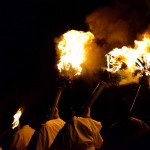Nara
Eight UNESCO World Heritage Sites guarded by some very hungry deer.
The ancient capital of Nara is home to some of the most important and impressive historical sites in Japan. The towering bronze Buddah at Todaiji temple is Nara’s jaw-dropping centerpiece, but it’s only one of eight UNESCO World Heritage sites all contained within a compact and very picturesque city.

The magnificent Todaiji temple houses one of the tallest Buddha in Japan.
Festivals of Japan: Wakakusa Yamayaki Festival in Nara

You can catch most of the highlights in around Nara Koen, a large green park filled with temples, shrines and immaculate gardens. The relics are well-supervised by the city’s famous deer, who use their protected status as godly messengers to their advantage, regularly harassing tourists for local shika senbei (rice crackers for deer) especially near Todaiji.
Most tourists who fall for the cracker trap instantly regret it, often being chased out of the park before they’ve even reached the temple.

Explore Nara’s picturesque streets as evening sets in.
If you’re staying overnight, about 12 km outside of Nara, Horyuji temple is one of Japan’s oldest temples and contains some of the world’s oldest surviving wooden structures. Nishinokoyo to the west of the city center is where you’ll find Yakushiji and Toshodaiji temples.
January visitors will get a chance to witness the Wakakusa Yamayaki, an annual festival more than one hundred years old where the grass of Mount Wakakusayama is set on fire, along with fireworks, religious ceremonies and general festival revelry.
Trivia

Festivals of Japan: Wakakusa Yamayaki Festival in Nara
Originating in the 18th century, the burning of Mount Wakakusa is one of Japan’s most spectacular winter festivals.
More

